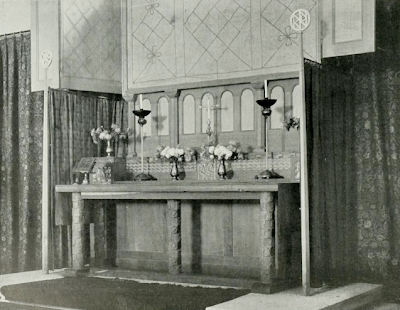Having done some more searching, I have found some more details about Luther Hooper's work at St Christopher's. Unfortunately I have not physically located the actual works!
 |
St. Christopher's Church, Haslemere c.1911
from Art Journal, February 1911 |
In the
Art Journal (February 1911) Luther Hooper wrote the first of two articles under the heading 'Art of To-day. Fine and Otherwise: Art in the Church'. Hooper uses St Christopher's Church, Haslemere to illustrate his message "In the church, if anywhere, everything should be made or carefully selected for its special place and use; all should be of the best of its kind and in harmony with all the rest. In fact art, in the church particularly, should be alive. This can never be if things are used which have been made at the lowest rate simply for money, and safely stocked by the tradesman and sold merely for profit...About St Christopher's, Haslemere there is nothing commonplace or ordinary, and at the same time nothing is bizarre or out of harmony. The church was built a few years ago, Mr. Charles Spooner being the architect , and from the first the committee wisely resolved not only to entrust the design of the fabric to him, but to take his advice on all matters of detail and furnishing. At the beginning only the absolutely necessary items were provided, and the congregation has been adding to them from time to time as circumstances allowed."
 |
Portion of Silk Damask, Side Curtain to Altar,
St. Christopher's, Haslemere
designed by Luther Hooper
from Art Journal, February 1911 |
The damask above is described as "red-gold silk damask altar curtains", from the photograph of the altar taken around the time, and also illustrated in the
Art Journal. Spooner describes that the "altar curtains are of red silk damask with copper coloured silk lining, designed by Luther Hooper" (Nicholson, C., and Spooner, C., Recent Eccelesiastical Architecture, Technical Journals Ltd., London, c.1910). I cannot identify the silk damask hung in the photograph below to be the same as that shown in detail above. Hooper describes that "their copper-coloured silk lining was woven by Messrs. Warner and Sons of London to the design of the writer" (Art Journal,
ibid).
 |
| Holy table by Arthur Romney Green,(Nicholson, C., and Spooner, C., Recent Eccelesiastical Architecture, Technical Journals Ltd., London, c.1910) |
The damask identified in the previous post is reproduced in the
Art Journal and is shown in situ. "Behind the choir stalls, opposite to the organ, is the choir vestry. It is only divided from the chancel by a heavy curtain. This curtain, of rich, bright colour, is not one of the least features of the decoration of the church. It is very heavy and wide. It measurer nine feet in height by twenty-two feet in width when extended. As it occupies only a space of eleven feet it naturally gathers up into beautiful and ample folds. It will be seen by the photograph that the curtain is not gathered formally into the usual band, but is allowed to hang in free folds from a lacing of leather thongs which suspend it more than a foot below a strong iron rod.
 |
Luther Hooper wool hanging fromHand-loom weaving, plain & ornamental,
Pitman & Sons, London, 1920 |
"The material of which the curtain is woven is fine wool and the colours are scarlet, cream, green and dark blue. The dark blue is the background. The vase and conventional plant is green, as is also the acanthus leaf which forms the structure of the design the latter being outlined with cream colour. The cream colour also outlines the brilliant scarlet lily which gives point and character to the whole.
 |
Curtain of Woollen Tissue, St Christopher's Church,
designed by Luther Hooper, woven by Percy C. Hooper,
from Art Journal, February 1911 |
"...On the reverse side, facing the choir vestry, the curtain is lined with a soft, strong material made of pure mercerised cotton. This is shown below the design "shows the somple design design of vine leaves and grapes and boundaries. The colours in the ornament are the same as those the wool surface of the curtain - blue, green and red - but these are much modified in strength by being interwoven with the cream colour of the ground." (
ibid). Unfortunately the British Periodicals copy of the Art Journal online (I have access through my University) is not a good photocopy, and hence the pictures are very dark.
 |
Reverse Side of Curtain (from above), Woven in pure cream mercerised cotton,
ornamented with green, blue and scarlet wool
Art Journal, February 1911 |
Spooner states that "another interesting feature of the interior is the curtain dividing the choir stalls from the vestry...It is a very fine piece of colour and was woven at Haslemere" (
Nicholson, C., and Spooner, C., Recent Eccelesiastical Architecture, Technical Journals Ltd., London, c.1910). Hooper states that the wool damask was woven in the weaving house which was at the time of his writing the location of the Country Church (on Kings Road).

























































